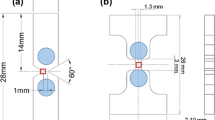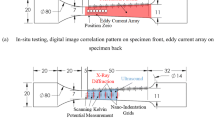Abstract
The use of optical correlation techniques to monitor fatigue damage in 2024-T3 aluminum alloy is described. Topographical information from the surface of a sheet specimen is recorded holographically and compared with the actual surface by measuring correlation intensity as fatigue damage accumulates. The hologram is recorded on a thermoplastic - photoconductor device that can be developed and erasedin situ, so that repeated recordings can be made easily during a fatigue test. The results are presented as curves of correlation intensity (I c) vs fatigue cycles(N) for unnotched specimens fatigued in tension-tension. The curves exhibit three regions, namely a decelerating loss of log Ic vs N over the first portion of the fatigue life (Region A), followed by a linear loss (RegionB), and finally by an accelerating loss over the final portion of the life (Region C). Changes in the initial surface finish of the specimen do not affect the general form of the correlation curve. Metallographic evidence indicates that the three regions correspond to fatigue-induced changes in the specimen surface, although dimensional changes in the specimen may also contribute to correlation losses. RegionA appears to correspond to a period of initial cyclic strain adjustment, and Region B to a period of crack initiation and/or early growth. RegionC corresponds to the presence of growing fatigue cracks, and the transition fromB to C occurs when the cracks exceed about 20 μm in length. Thus, the correlation intensity data provide a sensitive indication of accumulating fatigue damage and impending failure in individual specimens.
Similar content being viewed by others
Reference
E. Marom and R. K. Mueller: Proceedings of the Air Force Symposium on Aircraft Structures and Materials, p. 493,1969.
E. Marom:Holographic Nondestructive Testing, R. K. Erf, ed., chap. 6, Academic Press, New York, 1973.
R. L. Bond, R. E. Beissner, J. Lankford, Jr., and W. W. Bradshaw: NASA SP-299,p. 177, 1973.
W. L. Haworth, Thomas Cheng, A. F. Hieber, F. T. S. Yu, and R. K. Mueller:J. Eng. Mater. Technol, ASME Trans., 1977, vol. 99, ser. H, p. 229.
Campbell Laird:Treatise on Materials Science and Technology, vol. 6, p. 101,Plastic Deformation of Materials, R. J. Arsenault, ed., Academic Press, New York, 1975.
J. H. Plumbridge and D. A. Ryder:Met. Rev., 1969, vol. 3, no. 136, pp. 119- 42.
W. A. Backofen:Fracture, B. I. Averbach,et al, eds., p. 435, John Wiley, New York, 1959.
W. A.Wood: ibid, p. 412.
G. G. Goetz, R. K. Mueller, and D. M. Shupe:Recent Progress in A Real- Time 3-D Display, Proceedings of the IEEE Conference on Display Devices, New York, 1972.
W. S. Colburn and J. B. Dubow: Air Force Avionics Laboratory Technical Report 73-255, 1973.
W. S. Colburn and E. N. Tompkins:,Appl. Opt., 1974, vol. 13, p. 2934.
A. F. Hieber: M.S. Thesis, Department of Metallurgical Engineering, Wayne State University, 1976.
Author information
Authors and Affiliations
Additional information
formerly Graduate Student in the Department of Metallurgical Engineering, Wayne State University, Detroit, MI 48202 .
Rights and permissions
About this article
Cite this article
Haworth, W.L., Hieber, A.F. & Mueller, R.K. Fatigue damage detection in 2024 aluminum alloy by optical correlation. Metall Trans A 8, 1597–1604 (1977). https://doi.org/10.1007/BF02644865
Issue Date:
DOI: https://doi.org/10.1007/BF02644865




